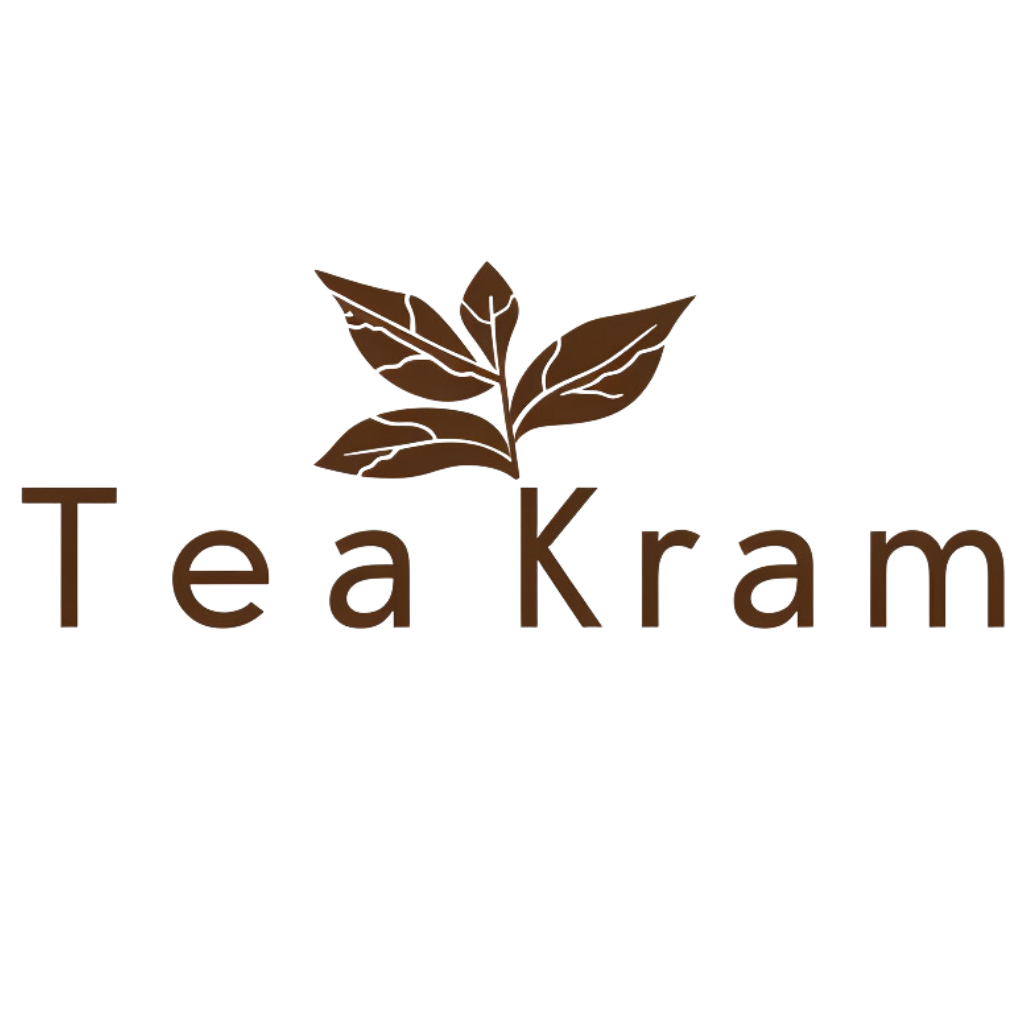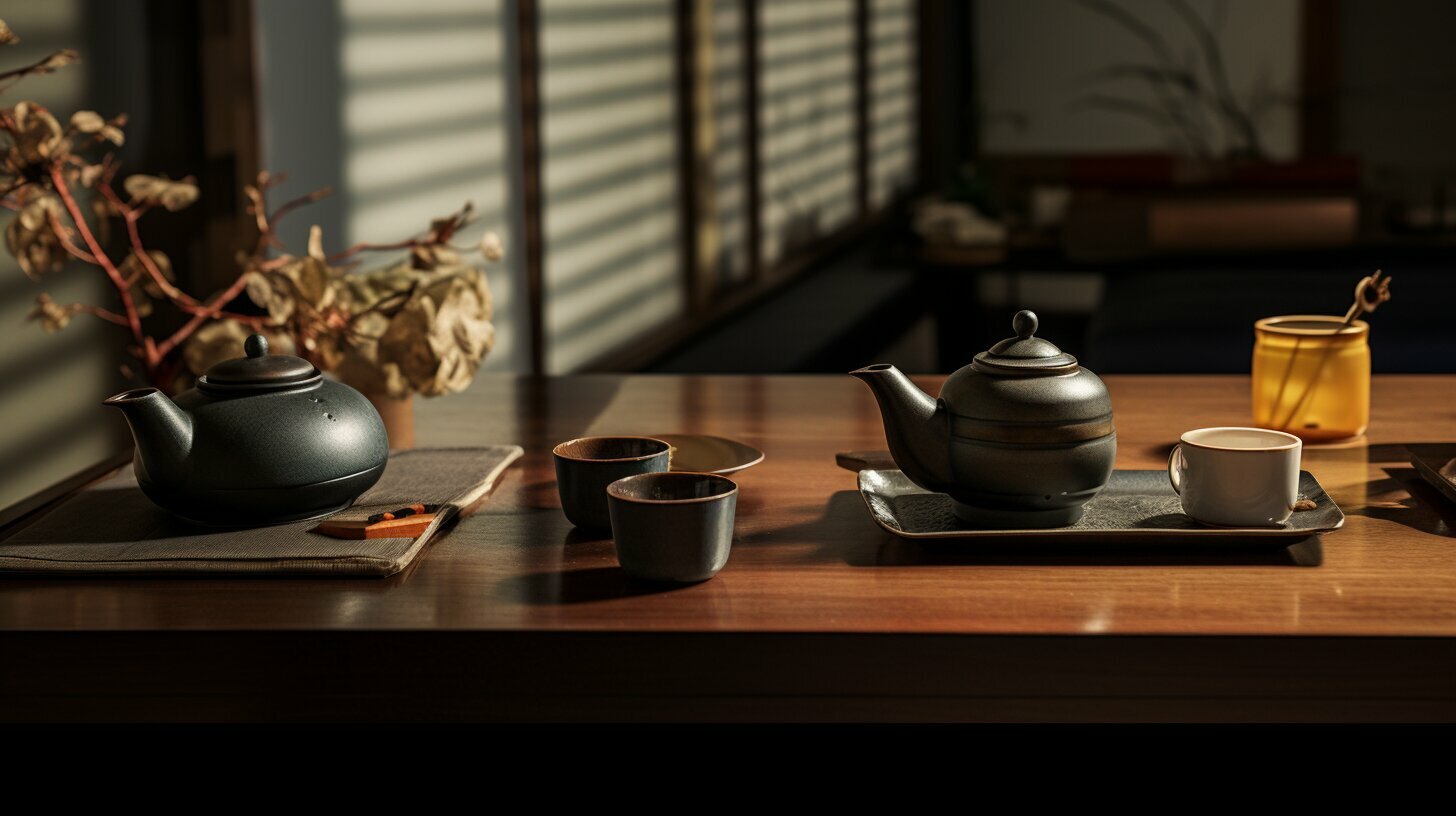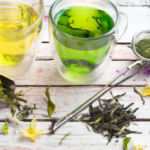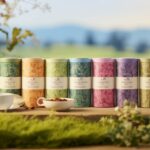Tea drinking has been a beloved tradition for centuries, and the tea pot has long been an essential accessory for brewing the perfect cup of tea. From the traditional ceramic tea pot to the modern glass and electric tea pots, the options are endless for tea enthusiasts. In this article, we’ll explore the history and evolution of tea pots, the different materials used to make them, and the cultural significance of tea pot sets in different regions.
Tea brewing is not just about making a simple cup of tea; it’s an art form. The right brewing equipment is necessary for the perfect cup. Whether it’s a traditional Japanese tea pot used in formal tea ceremonies or a modern electric tea pot for convenience, the right tea pot can enhance the tea-drinking experience.
Key Takeaways:
- Tea pots have a rich history and have evolved over time to include a variety of materials and designs.
- Tea brewing is an art form, and the right tea pot is essential for the perfect cup.
- Tea pot sets are culturally significant in regions like Japan and China.
The Origins of Tea Pot Brewing
Tea brewing is an art form that has been practiced for centuries, and with it came the development of the tea pot. The first tea pots were developed during the Tang Dynasty in China, around the 8th century, but it wasn’t until the Ming Dynasty that they became a popular tool for brewing tea.
During this time, tea was brewed in small, handleless cups and poured into a larger bowl for sharing. The tea pot served as a more convenient and efficient way to brew tea for multiple people at once. The earliest tea pots were made from ceramic, and their designs often reflected the culture and customs of the time.
Japanese tea pots, on the other hand, were not developed until the 17th century, when tea culture was introduced to Japan by Chinese monks. The Japanese refined the art of tea making, creating unique tea pot designs that reflected their own cultural aesthetic. Many Japanese tea pots were made from iron or clay, and their designs emphasized simplicity and utility.
Despite their differences in origin and design, both Chinese and Japanese tea pots are still popular tools for brewing tea today. From cast iron to silver, tea pots continue to come in a variety of materials, shapes, and sizes, each with their own unique characteristics and brewing benefits.
Whether you prefer a ceramic tea pot for its classic design or a glass tea pot for its transparency, there is a tea pot out there for every tea enthusiast. And with the rise of loose leaf tea brewing and tea accessories, it’s clear that the timeless accessory of the tea pot will continue to play a crucial role in tea culture for years to come.
Evolution of Tea Pot Designs
The design of tea pots has come a long way since its inception in ancient times. Today, tea pots come in a variety of materials and styles, from traditional ceramic to modern glass and electric tea pots.
Japanese tea pots, also known as kyusu, are a popular choice for tea enthusiasts. They are typically small and made of clay, with a side handle and a spout that pours low to the table. Chinese tea pots, on the other hand, are larger and made of various materials such as ceramic, glass, and copper. These tea pots often feature intricate designs and patterns, and are used for brewing a variety of teas.
In recent years, clear tea pots have become a trendy option for tea lovers. These tea pots are made of glass or heat-resistant borosilicate, allowing the drinker to watch the tea leaves steep and expand. Electric tea pots are another modern innovation, providing a quick and easy way to boil water and brew tea with programmable settings.
| Material | Characteristics |
|---|---|
| Ceramic | Durable and heat-resistant, retains heat well |
| Glass | Allows for a clear view of tea brewing, delicate and lightweight |
| Electric | Quick and convenient, programmable settings for brewing |
| Cast iron | Rust-resistant, retains heat well, adds flavor to tea |
| Silver | High-quality and durable, retains heat well |
| Copper | Excellent heat conductor, adds flavor to tea |
Tea pots with built-in strainers are a convenient option for those who prefer loose leaf tea. These tea pots often have a removable strainer basket or a built-in mesh filter, allowing the tea leaves to steep without getting into the cup. Vintage tea pots are also popular among collectors and tea enthusiasts, with unique designs and a sense of history.
Whether you prefer a traditional ceramic tea pot or a modern electric tea pot, there is no denying the importance and versatility of this timeless accessory.
Tea Pot Sets: The Perfect Combination
In tea culture, a tea pot set is a must-have for any brewing enthusiast. These sets often include matching tea cups and pots, adding to the aesthetic appeal of the brewing experience.
A tea pot set can come in a variety of designs and materials, including ceramic, glass, Japanese and Chinese tea pots, or a combination of different materials. The set is an essential part of the tea brewing process, providing a complete and elegant solution for brewing and serving tea.
The cultural significance of tea pot sets is particularly prominent in Japan and China, where they are seen as symbols of hospitality and respect for guests. These sets are often beautifully crafted and decorated, and can add a touch of elegance to any tea ritual.
In addition to their functional purpose, tea pot sets are also popular gift items and collector’s items. Ceramic and glass tea pot sets, in particular, are popular among collectors due to their intricate designs and unique shapes.
Whether used for brewing, serving, or collecting, a tea pot set is a perfect combination of functionality and style.
The Artistry of Tea Pot Drawing
Tea pots are not only functional brewing equipment, but they also serve as works of art. Tea pot drawing is an ancient tradition in Japan and China that involves intricate designs and patterns hand-drawn onto the surface of ceramic tea pots. These designs often reflect the cultural and historical significance of tea and its accessories.
Japanese tea pots, also known as kyusu, often feature simple and elegant designs that emphasize the natural beauty of the materials used. The designs are often inspired by nature, with patterns that illustrate the changing seasons or the flora and fauna of Japan. On the other hand, Chinese tea pots, or yixing, are known for their more complex designs that incorporate symbols and characters with deeper meanings.
Cast iron tea pots from Japan and silver tea pots from China are often regarded as some of the most beautiful and intricately designed tea pots, with elaborate drawings and patterns that reflect the rich cultural histories of their respective countries. The artistry of tea pot drawing is not limited to traditional designs, however, as modern artists and designers are using more contemporary techniques and styles to make tea pots that are both functional and artistic.
Whether you prefer vintage or modern tea pots, ceramic or glass, Japanese or Chinese-inspired, tea pot drawing is a testament to the enduring appeal of tea and its accessories. A tea pot with an exquisite drawing can be a priceless addition to any tea collection, and it is also a way to honor the rich cultural traditions that have made tea such an important part of our lives.
Tea Pots as Collectibles: Vintage and Unique Finds
If you’re a tea enthusiast, you know that the perfect tea pot can make all the difference when brewing your favorite loose leaf tea. But did you know that tea pots can also be collectibles? Vintage and unique tea pots are highly sought after by tea aficionados and collectors alike.
Ceramic and glass tea pots are some of the most popular designs for collectors. Vintage Japanese and Chinese tea pots are also highly valued, with hand-painted and hand-carved designs that reflect the artistic traditions of those cultures.
But it’s not just about the artistry. Tea pot materials can also add to their value as collectibles. Copper, cast iron, and silver tea pots are all highly prized for their durability, heat retention, and aesthetic appeal. Clear tea pots are another unique find that can be admired for their minimalist, sleek design.
| Tea Pot Type | Advantages |
|---|---|
| Ceramic Tea Pot | Durable, retains heat well, perfect for brewing all tea types. |
| Glass Tea Pot | Elegant design, allows you to observe the brewing process. |
| Japanese Tea Pot | Hand-painted and hand-carved designs, often made from ceramic or cast iron. |
| Chinese Tea Pot | Highly decorative, often adorned with intricate designs and patterns. |
| Copper Tea Pot | Excellent heat conductor, aesthetic appeal. |
| Cast Iron Tea Pot | Retains heat well, enhances flavor of tea. |
| Silver Tea Pot | Aesthetic appeal, often used for special occasions. |
| Clear Tea Pot | Sleek, minimalist design, allows for easy observation of tea color. |
Whether you’re a collector or just a lover of tea, vintage and unique tea pots can add a special touch to your brewing experience. Keep an eye out for these one-of-a-kind finds and appreciate them for their artistry and history.
Tea Pot Materials: Exploring the Options
Tea pots come in a variety of materials, each with their own unique qualities and characteristics. Let’s take a look at the most popular materials used for tea pots.
Ceramic Tea Pot
Ceramic tea pots are a classic choice and come in a range of styles and designs. They are durable and provide good heat retention, making them perfect for brewing tea. Ceramic tea pots are also easy to clean and maintain.
Glass Tea Pot
Glass tea pots are great for showcasing the color of your tea as it brews and are perfect for blooming teas. They are delicate and require careful handling, but are easy to clean and maintain. Glass tea pots also do not retain any flavor, allowing you to taste the true flavor of your tea.
Stainless Steel Tea Pot
Stainless steel tea pots are durable and long-lasting, providing excellent heat retention. They are also easy to clean and maintain, making them a popular choice for busy tea drinkers.
Copper Tea Pot
Copper tea pots come in a range of designs and are known for their excellent heat conductivity. They are also durable and long-lasting. However, they require regular cleaning and maintenance to prevent tarnishing.
Cast Iron Tea Pot
Cast iron tea pots are known for their superior heat retention and durability. They are also ideal for brewing tea at high temperatures. Cast iron tea pots require regular seasoning and should not be cleaned with soap.
Silver Tea Pot
Silver tea pots are a luxurious choice and are known for their excellent heat retention. They require regular polishing to maintain their shine and should be cleaned by hand to prevent tarnishing.
Clear Tea Pot
Clear tea pots are made from either glass or plastic and are perfect for showcasing the color of your tea as it brews. They are easy to clean and maintain, but may not provide the same heat retention as other materials.
Tea Pot with Strainer: Brewing Convenience
For loose-leaf tea enthusiasts, there’s nothing more satisfying than using a tea pot with a strainer to brew their favorite tea. The strainer ensures that the tea leaves are filtered out, leaving behind a perfectly brewed tea.
Tea pots with a strainer are available in different types of materials, including ceramic, glass, stainless steel, and electric. No matter the material, the strainer is designed to make tea brewing convenient and efficient.
Ceramic tea pots with strainers are durable and retain heat well, making them an excellent choice for brewing loose leaf tea. Glass tea pots with strainers are aesthetically pleasing, allowing you to watch your tea leaves unfurl while brewing. Stainless steel tea pots with strainers are durable, easy to clean, and retain heat well.
If you’re looking for even more convenience, electric tea pots with built-in strainers are a great option. Electric tea pots with strainers heat up quickly and allow you to set the temperature to your desired level, ensuring a perfect brew every time.
No matter which type of tea pot with a strainer you choose, you can enjoy the convenience of brewing loose leaf tea in a way that is both practical and efficient.
Modern Innovations: Electric Tea Pots
The convenience of electric tea pots has made them a popular choice for tea brewing. Electric tea pots are known for their modern innovations and features, making them an attractive option for tea enthusiasts who value convenience and efficiency. These tea pots come in different sizes, shapes, and materials, allowing you to choose the best one for your tea brewing needs.
Electric tea pots are designed to heat water quickly and efficiently, making them ideal for those who want to enjoy a cup of tea without waiting for the water to boil on the stove. They are also equipped with automatic shut-off features that prevent the tea pot from overheating or boiling dry.
When it comes to materials, electric tea pots are available in different options, such as glass, ceramic, and stainless steel. Glass and ceramic tea pots offer a clear view of the water and tea leaves, while stainless steel tea pots provide durability and strength. Some electric tea pots even come with temperature control settings that allow you to adjust the temperature according to the type of tea being brewed.
Whether you prefer an electric tea pot or a traditional tea pot, the most important thing is to enjoy your tea and the brewing process. Electric tea pots offer a contemporary solution for tea brewing while preserving the essence of traditional tea culture.
Tea Pot Trends: Stylish and Functional
Tea pots have come a long way from the traditional ceramic design. Today, tea enthusiasts have an array of stylish and functional options to choose from, including glass and stainless-steel varieties. Whether you prefer a vintage tea pot or a modern electric version, there is a tea pot to suit every taste and preference.
Japanese and Chinese tea pot designs are currently dominating the market, with their elegant and intricate patterns. The unique shapes and sizes of these tea pots also add to their appeal. However, if you’re looking for something more compact, a small tea pot might be the way to go. They’re perfect for single servings and take up minimal counter space.
For those who appreciate the beauty of vintage items, a vintage tea pot might be the ideal addition to your collection. These tea pots come in a variety of materials, such as copper and cast iron, and often feature unique designs and patterns.
Clear tea pots are another popular trend, allowing you to see the tea leaves as they steep. These tea pots are often made of glass or heat-resistant plastic, and are a great option for loose leaf tea brewing.
Finally, silver tea pots are timeless classics that never go out of style. Their elegant shine and durability make them a valuable investment for any tea lover.
The Global Love for Tea: Consumption Worldwide
Tea has long been a beloved beverage around the world, with consumption in numerous cultures dating back centuries. And with the continued popularity of tea, the demand for quality tea pots has only increased. From traditional ceramic tea pots to modern glass and stainless steel options, the variety of tea pot designs available reflects the universal love for tea and its accessories.
According to a recent report by Statista, China, India, and Turkey top the list of countries with the highest tea consumption per capita. Other countries such as the United Kingdom, Japan, and Russia are also known for their tea-drinking traditions.
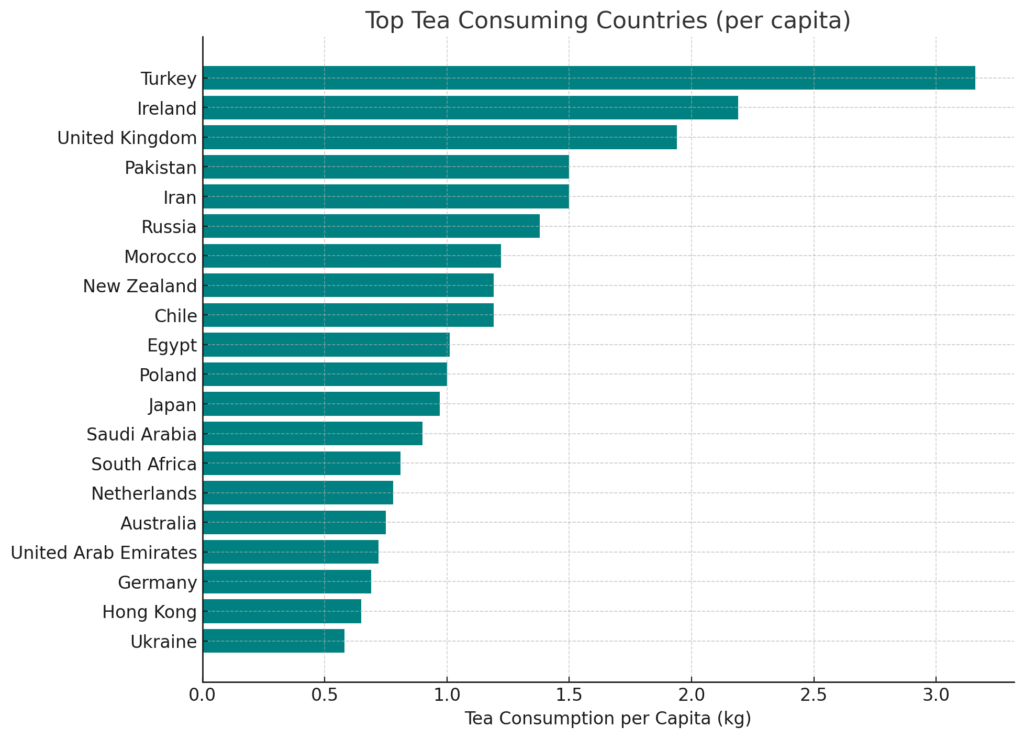
As tea consumption continues to increase globally, so does the demand for high-quality tea brewing equipment. Ceramic and glass tea pots remain popular choices for their classic and elegant designs, while stainless steel options offer a sleek and modern look.
Regardless of the design, the functionality of a tea pot remains essential for brewing the perfect cup of tea. With precise temperature settings and fine mesh strainers, today’s tea pots offer convenience and efficiency for tea enthusiasts worldwide.
As tea culture evolves and expands, the demand for unique and stylish tea pot designs continues to grow. From vintage and small tea pots to clear and silver options, there is a tea pot for every taste and preference. And with the growing popularity of Japanese and Chinese tea pot designs, the global love for tea and its accessories shows no signs of slowing down.
What are some traditional tea-drinking rituals that have been influenced by the use of the tea pot?
Tea time traditions and rituals of tea drinking have evolved along with the introduction of the tea pot. The Chinese tea ceremony, for instance, places great emphasis on using a traditional Yixing clay tea pot. In Japan, the tea ceremony called chado showcases the reverence for tea preparation using intricate tea pots like the kyusu. From pouring tea with precise movements to appreciating the aesthetics of these vessels, the tea pot has undoubtedly influenced and enriched tea-drinking rituals worldwide.
Conclusion
Throughout history, tea pots have played an important role in the ritual and culture of tea drinking. From the ancient origins of tea brewing to the modern innovations of electric tea pots, these timeless accessories have undergone a remarkable evolution.
Whether made from ceramic, glass, stainless steel, copper, cast iron, or silver, tea pots come in a variety of materials and designs to suit different tastes and styles. Tea pot sets, with their matching tea cups, remain a popular choice for tea enthusiasts and collectors, and vintage and unique tea pots are highly sought-after in the collector’s market.
Tea pot drawing, an art form that involves intricate designs and patterns hand-drawn on tea pots, adds a touch of elegance and cultural significance to these household items. And the convenience of using a tea pot with a built-in strainer for brewing loose leaf tea cannot be denied.
With the growing popularity of electric tea pots and the current trend of stylish and functional designs, tea pots continue to be a beloved accessory worldwide. From Japan and China to the rest of the world, tea drinking cultures have their own preferences for tea pot designs and styles, but the universal appeal of tea and its accessories remains strong.
In conclusion, the history and evolution of tea pots is a testament to the enduring popularity and significance of this timeless accessory. As tea continues to be a beloved beverage around the world, the demand for tea pots and their unique designs will undoubtedly continue to thrive for generations to come.
What Role Do Tea Leaves Play in the History of Tea?
Tea leaves hold an intriguing place in the history of tea. To truly grasp their significance, one must learn to read tea leaves. This ancient practice involves interpreting the patterns and symbols formed by the leaves in a teacup. It adds a mystical element to the tea-drinking experience and has been a part of tea culture for centuries. From predicting the future to gaining insight, the art of reading tea leaves unravels a fascinating realm of possibilities associated with this beloved beverage.
FAQ
Q: What is a tea pot?
A: A tea pot is a vessel used for brewing and serving tea. It typically has a spout and a handle for easy pouring.
Q: What materials are tea pots made of?
A: Tea pots can be made from a variety of materials, including ceramic, glass, stainless steel, copper, cast iron, and silver.
Q: How do I brew tea using a tea pot?
A: To brew tea using a tea pot, add tea leaves to the pot, pour hot water over them, and let steep for the desired amount of time. Then, pour the brewed tea into cups using the pot’s spout.
Q: Can I use a tea pot with a strainer for loose leaf tea?
A: Yes, many tea pots come with built-in strainers that are designed specifically for brewing loose leaf tea. The strainer helps to separate the tea leaves from the brewed tea when pouring.
Q: Are tea pots dishwasher safe?
A: It depends on the material of the tea pot. Ceramic, glass, and some stainless steel tea pots are generally dishwasher safe. However, it is best to check the manufacturer’s instructions for specific care guidelines.
Q: How do I clean a tea pot?
A: To clean a tea pot, rinse it with warm water and mild dish soap. Use a soft sponge or cloth to gently scrub the interior and exterior of the pot. Avoid using abrasive cleaners or brushes that could damage the surface.
Q: Can I use an electric tea pot to boil water for other beverages?
A: Yes, an electric tea pot can be used to boil water for any beverage or even for cooking purposes. It is a versatile kitchen appliance that provides convenient and fast boiling.
Q: How do I choose the right size tea pot?
A: The size of the tea pot depends on your personal preferences and needs. Consider how many people you usually serve tea to and how much tea you typically drink at once. A smaller tea pot is suitable for individuals or smaller gatherings, while a larger pot is ideal for larger groups.
Q: What are tea pot sets?
A: Tea pot sets typically include a tea pot and matching tea cups. They are designed to create a cohesive and aesthetically pleasing tea-drinking experience. Tea pot sets are often popular as gifts and for special occasions.
Q: Can I use a tea pot to brew herbal tea?
A: Yes, you can use a tea pot to brew herbal tea just like you would with any other type of tea. Follow the recommended brewing instructions for the specific herbal tea you are using.
Q: Are vintage tea pots valuable?
A: Vintage tea pots can be valuable depending on their rarity, condition, and historical significance. Certain antique and collectible tea pots can fetch high prices in the market.
